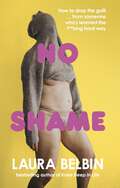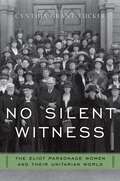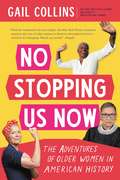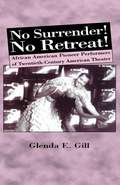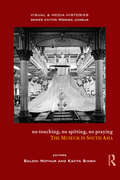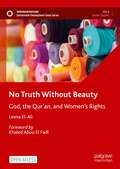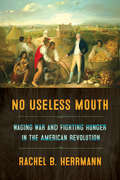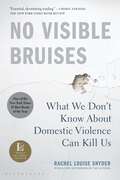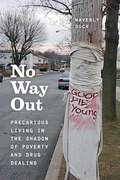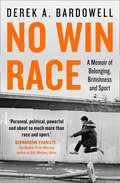- Table View
- List View
No Shame: How to drop the guilt … from some who’s learned the f**king hard way
by Laura BelbinShame, shame we know your nameDo we own it? Being a woman that is. Do we fuck! We live in fear of how we look, what we eat, how we age and what we do. Wow, it's 2022 and we're still churning out that same old shit. I've been told as you get older you care less. Fucking great. I can't wait to be menopausal with skunk-like grey track lines in my hair, saggier tits, and miserable as shit. I don't know about you, but I'd quite like to have that experience - the no-fucks-experience that is - now, before that all happens. To have the confidence to believe in who I am. It's a push we all have to make - whether it be in our confidence over our bodies, who we are as people, or what goes on inside our mind - and we all have to work at it. It's baby steps. So let's take it back to those tiny steps, because all mountains that are climbed don't happen without practice, perseverance, self-belief and a fuck ton of work.
No Silent Witness: The Eliot Parsonage Women and Their Unitarian World (Religion in America)
by Cynthia Grant TuckerThis group biography follows three generations of ministers' daughters and wives in a famed American Unitarian family. Cynthia Tucker examines the Eliots, their religious tradition, and the Eliot women's largely neglected female vocation. Spanning 150 years from the early 19th century forward, the narrative is shaped into a series of stories. Each of six chapters takes up a different woman's experience, from the deaths of numerous children and the anguish of infertility to the suffocation of small parish life with its chronic loneliness, doubt, and resentment.
No Silent Witness: The Eliot Parsonage Women and Their Unitarian World (Religion in America)
by Cynthia Grant TuckerThis group biography follows three generations of ministers' daughters and wives in a famed American Unitarian family. Cynthia Tucker examines the Eliots, their religious tradition, and the Eliot women's largely neglected female vocation. Spanning 150 years from the early 19th century forward, the narrative is shaped into a series of stories. Each of six chapters takes up a different woman's experience, from the deaths of numerous children and the anguish of infertility to the suffocation of small parish life with its chronic loneliness, doubt, and resentment.
The No-State Solution: A Jewish Manifesto
by Daniel BoyarinA provocative manifesto, arguing for a new understanding of the Jews’ peoplehood “A self-consciously radical statement that is both astute and joyous.”—Kirkus Reviews Today there are two seemingly mutually exclusive notions of what “the Jews” are: either a religion or a nation/ethnicity. The widespread conception is that the Jews were formerly either a religious community in exile or a nation based on Jewish ethnicity. The latter position is commonly known as Zionism, and all articulations of a political theory of Zionism are taken to be variations of that view. In this provocative book, based on his decades of study of the history of the Jews, Daniel Boyarin lays out the problematic aspects of this binary opposition and offers the outlines of a different—and very old—answer to the question of the identity of a diaspora nation. He aims to drive a wedge between the “nation” and the “state,” only very recently conjoined, and recover a robust sense of nationalism that does not involve sovereignty.
No Stopping Us Now: The Adventures of Older Women in American History
by Gail Collins"Gail Collins inspires women to embrace aging and look at it with a new sense of hope" in this lively, fascinating, eye-opening look at women and aging in America, by the beloved New York Times columnist (Parade Magazine)"You're not getting older, you're getting better," or so promised the famous 1970's ad--for women's hair dye. Americans have always had a complicated relationship with aging: embrace it, deny it, defer it--and women have been on the front lines of the battle, willingly or not. In her lively social history of American women and aging, acclaimed New York Times columnist Gail Collins illustrates the ways in which age is an arbitrary concept that has swung back and forth over the centuries. From Plymouth Rock (when a woman was considered marriageable if "civil and under fifty years of age"), to a few generations later, when they were quietly retired to elderdom once they had passed the optimum age for reproduction, to recent decades when freedom from striving in the workplace and caretaking at home is often celebrated, to the first female nominee for president, American attitudes towards age have been a moving target. Gail Collins gives women reason to expect the best of their golden years.
No Surrender! No Retreat!: African-American Pioneer Performers of 20th Century American Theater
by NA NANo Surrender! No Retreat! examines the careers of fifteen pioneer performers and their triumphs over herculean obstacles. It is a look back over the 20th century and documents personal histories of staggering achievement in spite of institutional racism, gender oppression, and classism. Twenty-four years in the making, No Surrender! No Retreat! is an indispensable work on African Americans in the performing arts, examining well-known performers, such as James Earl Jones, Morgan Freeman, and Pearl Bailey. Rare archival material and a number of personal interviews enrich this tome. Glenda E. Gill s work is a moving and sometimes tragic account of the lives and careers of some of America s most outstanding African American pioneers in theater.
No Time To Think: The Menace of Media Speed and the 24-hour News Cycle
by Howard Rosenberg Charles S. FeldmanAn eviscerating look at the state of journalism in the age of the 24 hour news cycle by a Pulitzer Prize-winning television critic and a veteran news correspondent. No Time To Think focuses on the insidious and increasing portion of the news media that, due to the dangerously extreme speed at which it is produced, is only half thought out, half true, and lazily repeated from anonymous sources interested in selling opinion and wild speculation as news. These news item can easily gain exposure today, assuming a life of their own while making a mockery of journalism and creating casualties of cool deliberation and thoughtful discourse. Much of it is picked up gratuitously and given resonance online or through CNN, Fox News, MSNBC and other networks, which must, in this age of the 24-hour news cycle, "feed the beast." In dissecting this frantic news blur, No Time to Think breaks down a number of speed-driven blunders from the insider perspective of Charles Feldman, who spent 20 years as a CNN correspondent, as well as the outsider perspective of Howard Rosenberg, who covered the coverage for 25 years as TV critic for The Los Angeles Times. No Time to Think demonstrates how today's media blitz scrambles the public's perspective in ways that potentially shape how we think, act and react as a global society. The end result effects not only the media and the public, but also the government leaders we trust to make carefully considered decisions on our behalf. Featuring interviews ranging from former NBC News anchor Tom Brokaw to internet doyenne Arianna Huffington to PBS stalwart Jim Lehrer to CNN chief Jonathan Klein to a host of former presidential press secretaries and other keen-eyed media watchers, this incisive work measures lasting fallout from the 24-hour news cycle beginning in 1980 with the arrival of CNN, right up to the present.
No Time To Think: The Menace of Media Speed and the 24-hour News Cycle
by Howard Rosenberg Charles S. FeldmanAn eviscerating look at the state of journalism in the age of the 24 hour news cycle by a Pulitzer Prize-winning television critic and a veteran news correspondent. No Time To Think focuses on the insidious and increasing portion of the news media that, due to the dangerously extreme speed at which it is produced, is only half thought out, half true, and lazily repeated from anonymous sources interested in selling opinion and wild speculation as news. These news item can easily gain exposure today, assuming a life of their own while making a mockery of journalism and creating casualties of cool deliberation and thoughtful discourse. Much of it is picked up gratuitously and given resonance online or through CNN, Fox News, MSNBC and other networks, which must, in this age of the 24-hour news cycle, "feed the beast." In dissecting this frantic news blur, No Time to Think breaks down a number of speed-driven blunders from the insider perspective of Charles Feldman, who spent 20 years as a CNN correspondent, as well as the outsider perspective of Howard Rosenberg, who covered the coverage for 25 years as TV critic for The Los Angeles Times. No Time to Think demonstrates how today's media blitz scrambles the public's perspective in ways that potentially shape how we think, act and react as a global society. The end result effects not only the media and the public, but also the government leaders we trust to make carefully considered decisions on our behalf. Featuring interviews ranging from former NBC News anchor Tom Brokaw to internet doyenne Arianna Huffington to PBS stalwart Jim Lehrer to CNN chief Jonathan Klein to a host of former presidential press secretaries and other keen-eyed media watchers, this incisive work measures lasting fallout from the 24-hour news cycle beginning in 1980 with the arrival of CNN, right up to the present.
No Touching, No Spitting, No Praying: The Museum in South Asia
by Kavita N AThis volume brings together a range of essays that offer a new perspective on the dynamic history of the museum as a cultural institution in South Asia. It traces the museum from its origin as a tool of colonialism and adoption as a vehicle of sovereignty in the nationalist period, till its role in the present, as it reflects the fissured identities of the post-colonial period.
No Touching, No Spitting, No Praying: The Museum in South Asia (Visual And Media Histories Ser.)
by Saloni Mathur Kavita SinghThis volume brings together a range of essays that offer a new perspective on the dynamic history of the museum as a cultural institution in South Asia. It traces the museum from its origin as a tool of colonialism and adoption as a vehicle of sovereignty in the nationalist period, till its role in the present, as it reflects the fissured identities of the post-colonial period.
No Truth Without Beauty: God, the Qur’an, and Women's Rights (Sustainable Development Goals Series)
by Leena El-AliIn this comprehensive open access book, written for readers from any or no religious background, Leena El-Ali does something remarkable. Never before has anyone taken on every last claim relating to Islam and women and countered it not just with Qur’anic evidence to the contrary, but with easy-to-use tools available to all. How can a woman’s testimony be worth half of a man’s? How can men divorce their wives unilaterally by uttering three words? And what’s with the obsession with virgins in Paradise? Find the chapter on any of the seventeen topics in this book, and you will quickly learn a) where the myth came from and b) how to bust it. The methodology pursued is simple. First, the Qur’an is given priority over all other literary or “scriptural” sources. Second, the meaning of its verses in the original Arabic is highlighted, in contrast to English translations and/or widespread misunderstanding or misinterpretation.
No Turning Back: The Peacetime Revolutions of Post-War Britain
by Paul AddisonIn No Turning Back, Paul Addison takes the long view, charting the vastly changing character of British society since the end of the Second World War. As he shows, in this period a series of peaceful revolutions has completely transformed the country so that, with the advantage of a longer perspective, the comparative peace and growing prosperity of the second half of the twentieth century appear as more powerful solvents of settled ways of life than the Battle of the Somme or the Blitz. We have come to take for granted a welfare state which would have seemed extraordinary to our forebears in the first decades of the century, based upon the achievement of a hitherto undreamed of mass prosperity. Much of the sexual morality preached if not practised for centuries has been dismantled with the creation of a 'permissive society'. The employment and career chances of women have been revolutionized. A white nation has been transformed into a multiracial one. An economy founded on manufacturing under the watchful eye of the 'gentlemen in Whitehall' has morphed into a free market system, heavily dependent on finance, services, and housing, while a predominantly working class society has evolved into a predominantly middle class one. And the United Kingdom, which once looked as solid as the rock of Gibraltar, now looks increasingly fragile, as Wales and especially Scotland have started to go their separate ways. The book ends with an assessment of the gains and losses that have resulted. As this makes clear, this is not a story of progress pure and simple, it is a story of fundamental transformation in which much has been gained and much also lost, perhaps above all a sense of the ties that used to bind people together. Paul Addison brings to it the personal point of view of someone who has lived through it all and seen the Britain of his youth turn into a very different country, but who in the final reckoning still prefers the present to the past.
No Useless Mouth: Waging War and Fighting Hunger in the American Revolution
by Rachel B. HerrmannIn the era of the American Revolution, the rituals of diplomacy between the British, Patriots, and Native Americans featured gifts of food, ceremonial feasts, and a shared experience of hunger. When diplomacy failed, Native Americans could destroy food stores and cut off supply chains in order to assert authority. Black colonists also stole and destroyed food to ward off hunger and carve out tenuous spaces of freedom. Hunger was a means of power and a weapon of war.In No Useless Mouth, Rachel B. Herrmann argues that Native Americans and formerly enslaved black colonists ultimately lost the battle against hunger and the larger struggle for power because white British and United States officials curtailed the abilities of men and women to fight hunger on their own terms. By describing three interrelated behaviors—food diplomacy, victual imperialism, and victual warfare—the book shows that, during this tumultuous period, hunger prevention efforts offered strategies to claim power, maintain communities, and keep rival societies at bay.Herrmann shows how Native Americans, free blacks, and enslaved peoples were "useful mouths"—not mere supplicants for food, without rights or power—who used hunger for cooperation and violence, and took steps to circumvent starvation. Her wide-ranging research on black Loyalists, Iroquois, Cherokee, Creek, and Western Confederacy Indians demonstrates that hunger creation and prevention were tools of diplomacy and warfare available to all people involved in the American Revolution. Placing hunger at the center of these struggles foregrounds the contingency and plurality of power in the British Atlantic during the Revolutionary Era.Thanks to generous funding from Cardiff University, the ebook editions of this book are available as Open Access volumes from Cornell Open (cornellopen.org) and other repositories.
No Visible Bruises: What We Don’t Know About Domestic Violence Can Kill Us
by Rachel Louise Snyder“A seminal and breathtaking account of why home is the most dangerous place to be a woman . . . A tour de force.” -Eve Ensler"Terrifying, courageous reportage from our internal war zone, a fair and balanced telling of an unfair and unbalanced crisis in American family life." -Andrew Solomon, National Book Award-winning, bestselling author of The Noonday Demon, Far From the Tree, and Far and Away“Gut-wrenching, required reading.”-EsquireAn award-winning journalist's intimate investigation of the true scope of domestic violence, revealing how the roots of America's most pressing social crises are buried in abuse that happens behind closed doors. We call it domestic violence. We call it private violence. Sometimes we call it intimate terrorism. But whatever we call it, we generally do not believe it has anything at all to do with us, despite the World Health Organization deeming it a “global epidemic.” In America, domestic violence accounts for 15 percent of all violent crime, and yet it remains locked in silence, even as its tendrils reach unseen into so many of our most pressing national issues, from our economy to our education system, from mass shootings to mass incarceration to #MeToo. We still have not taken the true measure of this problem.In No Visible Bruises, journalist Rachel Louise Snyder gives context for what we don't know we're seeing. She frames this urgent and immersive account of the scale of domestic violence in our country around key stories that explode the common myths-that if things were bad enough, victims would just leave; that a violent person cannot become nonviolent; that shelter is an adequate response; and most insidiously that violence inside the home is a private matter, sealed from the public sphere and disconnected from other forms of violence. Through the stories of victims, perpetrators, law enforcement, and reform movements from across the country, Snyder explores the real roots of private violence, its far-reaching consequences for society, and what it will take to truly address it.
No Way Out: Precarious Living in the Shadow of Poverty and Drug Dealing
by Waverly DuckIn 2005 Waverly Duck was called to a town he calls Bristol Hill to serve as an expert witness in the sentencing of drug dealer Jonathan Wilson. Convicted as an accessory to the murder of a federal witness and that of a fellow drug dealer, Jonathan faced the death penalty, and Duck was there to provide evidence that the environment in which Jonathan had grown up mitigated the seriousness of his alleged crimes. Duck’s exploration led him to Jonathan’s church, his elementary, middle, and high schools, the juvenile facility where he had previously been incarcerated, his family and friends, other drug dealers, and residents who knew him or knew of him. After extensive ethnographic observations, Duck found himself seriously troubled and uncertain: Are Jonathan and others like him a danger to society? Or is it the converse—is society a danger to them? Duck’s short stay in Bristol Hill quickly transformed into a long-term study—one that forms the core of No Way Out. This landmark book challenges the common misconception of urban ghettoes as chaotic places where drug dealing, street crime, and random violence make daily life dangerous for their residents. Through close observations of daily life in these neighborhoods, Duck shows how the prevailing social order ensures that residents can go about their lives in relative safety, despite the risks that are embedded in living amid the drug trade. In a neighborhood plagued by failing schools, chronic unemployment, punitive law enforcement, and high rates of incarceration, residents are knit together by long-term ties of kinship and friendship, and they base their actions on a profound sense of community fairness and accountability. Duck presents powerful case studies of individuals whose difficulties flow not from their values, or a lack thereof, but rather from the multiple obstacles they encounter on a daily basis. No Way Out explores how ordinary people make sense of their lives within severe constraints and how they choose among unrewarding prospects, rather than freely acting upon their own values. What emerges is an important and revelatory new perspective on the culture of the urban poor.
No Way Out: Precarious Living in the Shadow of Poverty and Drug Dealing
by Waverly DuckIn 2005 Waverly Duck was called to a town he calls Bristol Hill to serve as an expert witness in the sentencing of drug dealer Jonathan Wilson. Convicted as an accessory to the murder of a federal witness and that of a fellow drug dealer, Jonathan faced the death penalty, and Duck was there to provide evidence that the environment in which Jonathan had grown up mitigated the seriousness of his alleged crimes. Duck’s exploration led him to Jonathan’s church, his elementary, middle, and high schools, the juvenile facility where he had previously been incarcerated, his family and friends, other drug dealers, and residents who knew him or knew of him. After extensive ethnographic observations, Duck found himself seriously troubled and uncertain: Are Jonathan and others like him a danger to society? Or is it the converse—is society a danger to them? Duck’s short stay in Bristol Hill quickly transformed into a long-term study—one that forms the core of No Way Out. This landmark book challenges the common misconception of urban ghettoes as chaotic places where drug dealing, street crime, and random violence make daily life dangerous for their residents. Through close observations of daily life in these neighborhoods, Duck shows how the prevailing social order ensures that residents can go about their lives in relative safety, despite the risks that are embedded in living amid the drug trade. In a neighborhood plagued by failing schools, chronic unemployment, punitive law enforcement, and high rates of incarceration, residents are knit together by long-term ties of kinship and friendship, and they base their actions on a profound sense of community fairness and accountability. Duck presents powerful case studies of individuals whose difficulties flow not from their values, or a lack thereof, but rather from the multiple obstacles they encounter on a daily basis. No Way Out explores how ordinary people make sense of their lives within severe constraints and how they choose among unrewarding prospects, rather than freely acting upon their own values. What emerges is an important and revelatory new perspective on the culture of the urban poor.
No Way Out: Precarious Living in the Shadow of Poverty and Drug Dealing
by Waverly DuckIn 2005 Waverly Duck was called to a town he calls Bristol Hill to serve as an expert witness in the sentencing of drug dealer Jonathan Wilson. Convicted as an accessory to the murder of a federal witness and that of a fellow drug dealer, Jonathan faced the death penalty, and Duck was there to provide evidence that the environment in which Jonathan had grown up mitigated the seriousness of his alleged crimes. Duck’s exploration led him to Jonathan’s church, his elementary, middle, and high schools, the juvenile facility where he had previously been incarcerated, his family and friends, other drug dealers, and residents who knew him or knew of him. After extensive ethnographic observations, Duck found himself seriously troubled and uncertain: Are Jonathan and others like him a danger to society? Or is it the converse—is society a danger to them? Duck’s short stay in Bristol Hill quickly transformed into a long-term study—one that forms the core of No Way Out. This landmark book challenges the common misconception of urban ghettoes as chaotic places where drug dealing, street crime, and random violence make daily life dangerous for their residents. Through close observations of daily life in these neighborhoods, Duck shows how the prevailing social order ensures that residents can go about their lives in relative safety, despite the risks that are embedded in living amid the drug trade. In a neighborhood plagued by failing schools, chronic unemployment, punitive law enforcement, and high rates of incarceration, residents are knit together by long-term ties of kinship and friendship, and they base their actions on a profound sense of community fairness and accountability. Duck presents powerful case studies of individuals whose difficulties flow not from their values, or a lack thereof, but rather from the multiple obstacles they encounter on a daily basis. No Way Out explores how ordinary people make sense of their lives within severe constraints and how they choose among unrewarding prospects, rather than freely acting upon their own values. What emerges is an important and revelatory new perspective on the culture of the urban poor.
No Way Out: Precarious Living in the Shadow of Poverty and Drug Dealing
by Waverly DuckIn 2005 Waverly Duck was called to a town he calls Bristol Hill to serve as an expert witness in the sentencing of drug dealer Jonathan Wilson. Convicted as an accessory to the murder of a federal witness and that of a fellow drug dealer, Jonathan faced the death penalty, and Duck was there to provide evidence that the environment in which Jonathan had grown up mitigated the seriousness of his alleged crimes. Duck’s exploration led him to Jonathan’s church, his elementary, middle, and high schools, the juvenile facility where he had previously been incarcerated, his family and friends, other drug dealers, and residents who knew him or knew of him. After extensive ethnographic observations, Duck found himself seriously troubled and uncertain: Are Jonathan and others like him a danger to society? Or is it the converse—is society a danger to them? Duck’s short stay in Bristol Hill quickly transformed into a long-term study—one that forms the core of No Way Out. This landmark book challenges the common misconception of urban ghettoes as chaotic places where drug dealing, street crime, and random violence make daily life dangerous for their residents. Through close observations of daily life in these neighborhoods, Duck shows how the prevailing social order ensures that residents can go about their lives in relative safety, despite the risks that are embedded in living amid the drug trade. In a neighborhood plagued by failing schools, chronic unemployment, punitive law enforcement, and high rates of incarceration, residents are knit together by long-term ties of kinship and friendship, and they base their actions on a profound sense of community fairness and accountability. Duck presents powerful case studies of individuals whose difficulties flow not from their values, or a lack thereof, but rather from the multiple obstacles they encounter on a daily basis. No Way Out explores how ordinary people make sense of their lives within severe constraints and how they choose among unrewarding prospects, rather than freely acting upon their own values. What emerges is an important and revelatory new perspective on the culture of the urban poor.
No Way Out: Precarious Living in the Shadow of Poverty and Drug Dealing
by Waverly DuckIn 2005 Waverly Duck was called to a town he calls Bristol Hill to serve as an expert witness in the sentencing of drug dealer Jonathan Wilson. Convicted as an accessory to the murder of a federal witness and that of a fellow drug dealer, Jonathan faced the death penalty, and Duck was there to provide evidence that the environment in which Jonathan had grown up mitigated the seriousness of his alleged crimes. Duck’s exploration led him to Jonathan’s church, his elementary, middle, and high schools, the juvenile facility where he had previously been incarcerated, his family and friends, other drug dealers, and residents who knew him or knew of him. After extensive ethnographic observations, Duck found himself seriously troubled and uncertain: Are Jonathan and others like him a danger to society? Or is it the converse—is society a danger to them? Duck’s short stay in Bristol Hill quickly transformed into a long-term study—one that forms the core of No Way Out. This landmark book challenges the common misconception of urban ghettoes as chaotic places where drug dealing, street crime, and random violence make daily life dangerous for their residents. Through close observations of daily life in these neighborhoods, Duck shows how the prevailing social order ensures that residents can go about their lives in relative safety, despite the risks that are embedded in living amid the drug trade. In a neighborhood plagued by failing schools, chronic unemployment, punitive law enforcement, and high rates of incarceration, residents are knit together by long-term ties of kinship and friendship, and they base their actions on a profound sense of community fairness and accountability. Duck presents powerful case studies of individuals whose difficulties flow not from their values, or a lack thereof, but rather from the multiple obstacles they encounter on a daily basis. No Way Out explores how ordinary people make sense of their lives within severe constraints and how they choose among unrewarding prospects, rather than freely acting upon their own values. What emerges is an important and revelatory new perspective on the culture of the urban poor.
No Way Out: Precarious Living in the Shadow of Poverty and Drug Dealing
by Waverly DuckIn 2005 Waverly Duck was called to a town he calls Bristol Hill to serve as an expert witness in the sentencing of drug dealer Jonathan Wilson. Convicted as an accessory to the murder of a federal witness and that of a fellow drug dealer, Jonathan faced the death penalty, and Duck was there to provide evidence that the environment in which Jonathan had grown up mitigated the seriousness of his alleged crimes. Duck’s exploration led him to Jonathan’s church, his elementary, middle, and high schools, the juvenile facility where he had previously been incarcerated, his family and friends, other drug dealers, and residents who knew him or knew of him. After extensive ethnographic observations, Duck found himself seriously troubled and uncertain: Are Jonathan and others like him a danger to society? Or is it the converse—is society a danger to them? Duck’s short stay in Bristol Hill quickly transformed into a long-term study—one that forms the core of No Way Out. This landmark book challenges the common misconception of urban ghettoes as chaotic places where drug dealing, street crime, and random violence make daily life dangerous for their residents. Through close observations of daily life in these neighborhoods, Duck shows how the prevailing social order ensures that residents can go about their lives in relative safety, despite the risks that are embedded in living amid the drug trade. In a neighborhood plagued by failing schools, chronic unemployment, punitive law enforcement, and high rates of incarceration, residents are knit together by long-term ties of kinship and friendship, and they base their actions on a profound sense of community fairness and accountability. Duck presents powerful case studies of individuals whose difficulties flow not from their values, or a lack thereof, but rather from the multiple obstacles they encounter on a daily basis. No Way Out explores how ordinary people make sense of their lives within severe constraints and how they choose among unrewarding prospects, rather than freely acting upon their own values. What emerges is an important and revelatory new perspective on the culture of the urban poor.
No Win Race: A Story of Belonging, Britishness and Sport
by Derek A. BardowellA SUNDAY TIMES SPORTS BOOK OF THE YEAR A FINANCIAL TIMES SPORTS BOOK OF THE YEAR LONGLISTED FOR THE WILLIAM HILL SPORTS BOOK OF THE YEAR ‘Personal, political, powerful and about so much more than race and sport.’ Bernadine Evaristo
Nobel Peace Prize (large print)
by RnibThis page shows an image of a Nobel Peace Prize medal. There is a locator dot shown, which will be at the top left when the image is the correct way up. The medal is circular and has a slightly raised image of Alfred Nobel's head and shoulders. He is looking to the left and is wearing a suit jacket and a bowtie. He has a short but dense beard and moustache. To his left is his name in raised lettering. To his right are the dates of his birth (1833) and death (1896) in raised Roman numerals. The medal is made of gold and has no other colours. The textures on the tactile version are for tactile clarity and do not represent different colours.
Nobel Peace Prize (UEB contracted)
by RnibThis page shows an image of a Nobel Peace Prize medal. There is a locator dot shown, which will be at the top left when the image is the correct way up. The medal is circular and has a slightly raised image of Alfred Nobel's head and shoulders. He is looking to the left and is wearing a suit jacket and a bowtie. He has a short but dense beard and moustache. To his left is his name in raised lettering. To his right are the dates of his birth (1833) and death (1896) in raised Roman numerals. The medal is made of gold and has no other colours. The textures on the tactile version are for tactile clarity and do not represent different colours.
Nobel Peace Prize (UEB uncontracted)
by RnibThis page shows an image of a Nobel Peace Prize medal. There is a locator dot shown, which will be at the top left when the image is the correct way up. The medal is circular and has a slightly raised image of Alfred Nobel's head and shoulders. He is looking to the left and is wearing a suit jacket and a bowtie. He has a short but dense beard and moustache. To his left is his name in raised lettering. To his right are the dates of his birth (1833) and death (1896) in raised Roman numerals. The medal is made of gold and has no other colours. The textures on the tactile version are for tactile clarity and do not represent different colours.
The Nobility and Excellence of Women and the Defects and Vices of Men (The Other Voice in Early Modern Europe)
by Lucrezia MarinellaA gifted poet, a women's rights activist, and an expert on moral and natural philosophy, Lucrezia Marinella (1571-1653) was known throughout Italy as the leading female intellectual of her age. Born into a family of Venetian physicians, she was encouraged to study, and, fortunately, she did not share the fate of many of her female contemporaries, who were forced to join convents or were pressured to marry early. Marinella enjoyed a long literary career, writing mainly religious, epic, and pastoral poetry, and biographies of famous women in both verse and prose. Marinella's masterpiece, The Nobility and Excellence of Women, and the Defects and Vices of Men was first published in 1600, composed at a furious pace in answer to Giusepe Passi's diatribe about women's alleged defects. This polemic displays Marinella's vast knowledge of the Italian poetic tradition and demonstrates her ability to argue against authors of the misogynist tradition from Boccaccio to Torquato Tasso. Trying to effect real social change, Marinella argued that morally, intellectually, and in many other ways, women are superior to men.
